

.jpg)
Hanna von Goeler. Grey Wagtail, Motacilla Cinerea, 2023 on defunct Bank of Scotland note. Photo: Veronica Simpson.
Talbot Rice Gallery, Edinburgh
17 March – 27 May 2023
by VERONICA SIMPSON
The lilting Cuban rhythms of Pablo Nuevo, a song made famous by the film Buena Vista Social Club, which celebrated a generation of extraordinary Cuban musicians who had fallen “out of currency”, pulse around the colourful cutout figures in Lubaina Himid’s installation Naming the Money (2004). Musicians, ceramicists, herbalists, toymakers, shoemakers and dog trainers fill the entire lower Georgian hall at Talbot Rice Gallery, Edinburgh, pirouetting with fluted, neoclassical pillars, with each other and – most magically – with the visitors as they tour the space.
The title of this danzón-style Cuban classic translates appropriately as New Town, as the 25 figures appear to make up a whole community – though there were 100 of them in the original artwork. Each figure is expertly arranged so that the viewer must weave around them as the soundtrack moves from Cuban heat to the cool courts of Europe and 17th-century viola da gamba instrumentation. Peering at the “invoices” Himid has stapled to each of their backs, we find, in the “item description” column, haiku-esque biographies flagging up both their real names and those given to them by their masters, such as: “My name is Kankebe. They call me Sam. I used to shout from the hilltops. Now I call the dogs to heel. But I can still sing.”
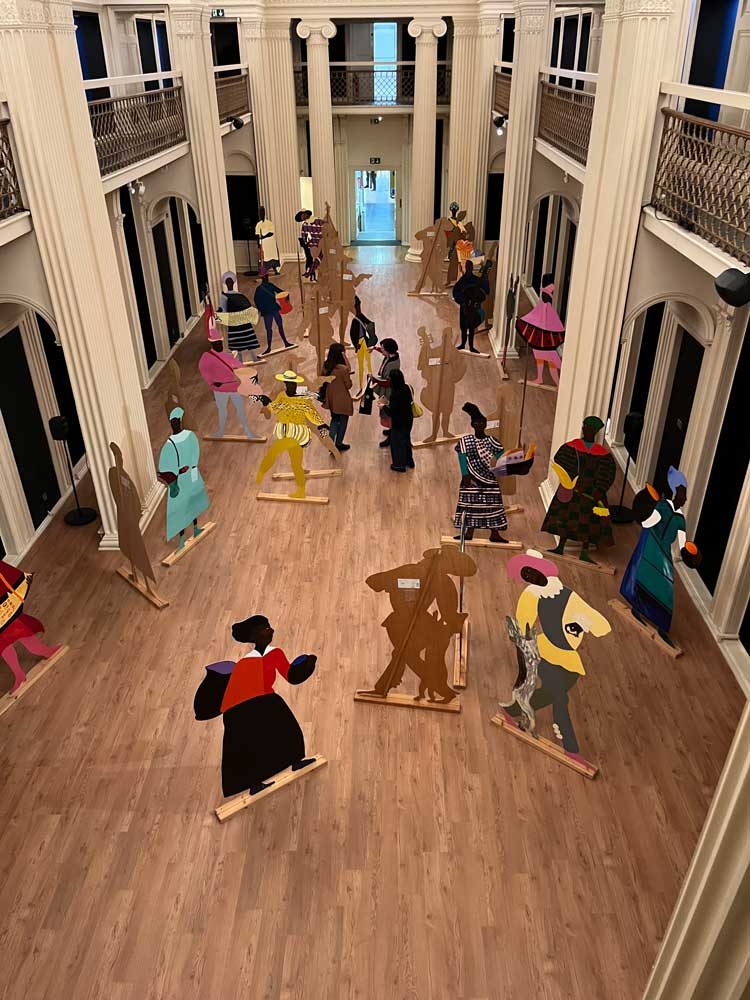
Lubaina Himid, Naming the Money, installation view, Talbot Rice Gallery, 2023. Photo: Veronica Simpson.
Himid’s inspiration for this work were the many African slaves who have appeared in portraits and paintings of European aristocracy, from the colonial expansion of the 17th century onwards (paintings such as Pierre Mignard’s 1862 Portrait of Louise de Kéroualle, Duchess of Plymouth with an Unknown Female Attendant, or William Dobson’s John 1st Baron of Rochester, 1643). In a message to the Hatton Gallery curator who staged Naming the Money in its first showing in 2004, Himid said: “I realise that this work is much more about naming than it is about money. It is an attempt to get to the bottom of the dilemma of losing your name, being relieved of your real identity, being saddled with another more convenient or less embarrassing identity and how you then have to invent something else equally real simply to survive, to make sense of being alive.”
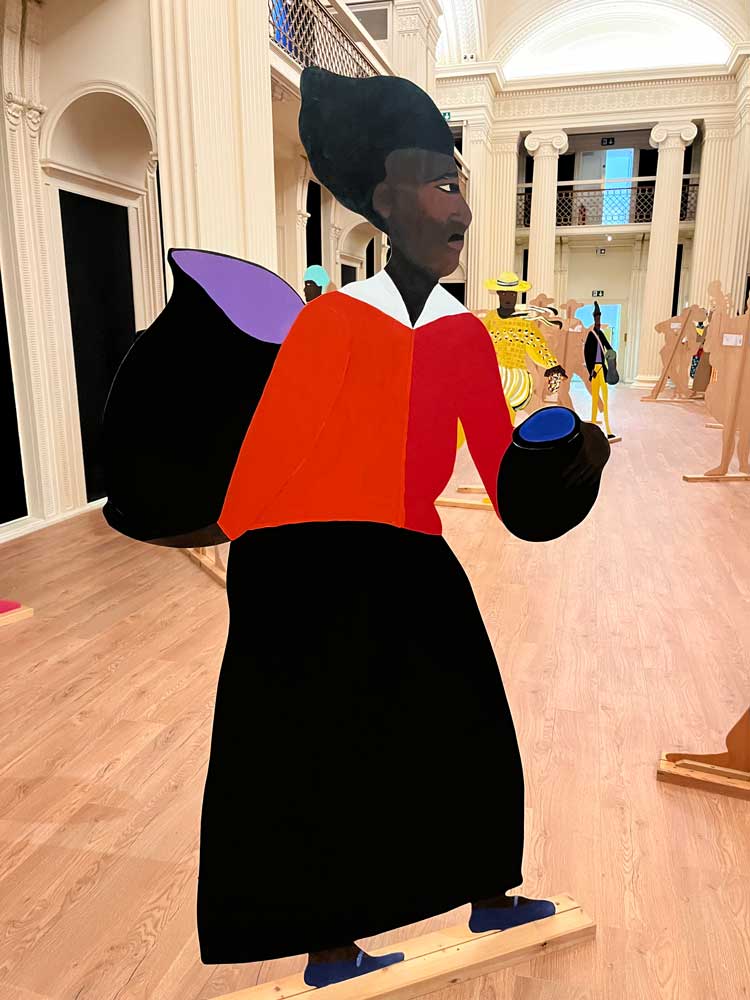
Lubaina Himid, Naming the Money, installation view, Talbot Rice Gallery, 2023. Photo: Veronica Simpson.
It is a judicious move to position this engaging work at the end of the show: having taken us through so much of the worst aspects of capitalism intellectually, we are placed, bodily, at the centre of what it might feel like to be, in your intrinsic self, a transactional object.
The focus throughout the show zooms in and out, spanning the globe, incorporating a multitude of materials and perspectives. We kick off with Cian Dayrit’s assorted wooden sculptures, paintings and embroideries, which line the interior walls of the first gallery. Dayrit (b1989, Philippines) frequently works with marginalised Filipino communities, articulating their struggles to survive the country’s feudal system of exploitative labour and mineral extraction, which privileges the few and perpetuates poverty and environmental degradation.
.jpg)
Close up of one of Cian Dayrit's five part series Terra Rationarium, 2018. Photo: Veronica Simpson.
There are boxed “houses” from his 2018 work Terra Rationarium, displaying icons and images that tell these stories through a layering of text, image and object. This device marries the picturesquely surreal quality of Joseph Cornell’s assemblages with the menace and iconography of Voodoo altars. In his tapestries, Dayrit maps the systems of exploitation and corruption more explicitly, using imagery that evokes medieval manuscripts or early cartography to help embed the understanding of how ancient and enduring these systems are.
.jpg)
Cian Dayrit. Valley of Dispossession, 2021. Photo: Veronica Simpson.
Talbot Rice Gallery curator James Clegg says: “This is almost an encyclopaedia of the issues that Filipino people face around the degradation of human rights, from farmers who were executed because they were trying to grow crops on land that was given over to plantations, to the death of fishermen due to their boats being rammed by Chinese military vessels.”
But the issues could apply to so many nations in the global south, he says. It was works by artists such as Dayrit that gave Clegg confidence that there was enough range and scope to build a show around debt. “Debt is always there,” says Clegg, for whom the show’s formative reading included David Graeber’s 2011 book: Debt: The First 5,000 years. Clegg says: “If you go back to the roots of money, the first users of money were soldiers. When they conquered lands, they then had to pay communities with tokens to say our queen or king will pay you back, in order to get clothes and food. And Graeber charts that right up to today, where the US federal debt and US military spending are almost the same – he shows it clearly on a graph. So, he’s saying your money is only worth as much as the man with the gun standing behind you says it is.
“It felt like those ideas opened up the subject of debt from a lot of different perspectives, particularly that idea of a system drawing from violence and reproducing violence that I felt the artists in this show were looking at really well, but it’s quite mercurial, it slips and changes through the different works.”
The show’s title is taken from The Accursed Share: An Essay on General Economy, a 1949 book by the French intellectual Georges Bataille. Clegg paraphrases: “He argues that everything that’s living has an excess of energy that allows it to expand and reproduce, but once you reach the limits of that container, the only thing you can do with that energy is destroy it.”
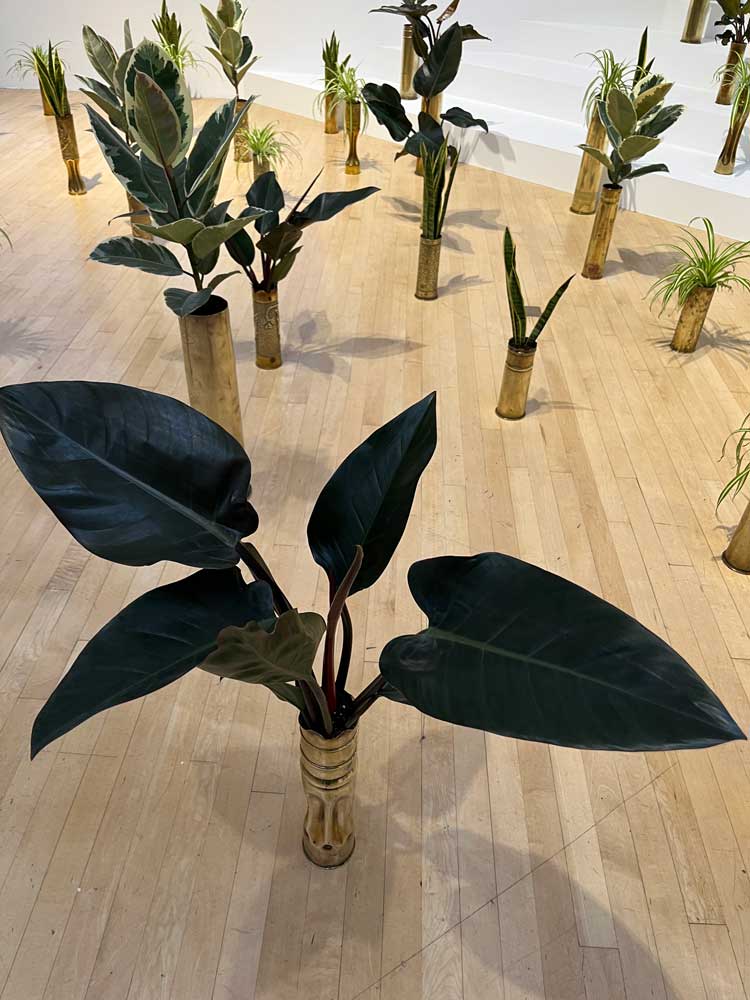
Sammy Baloji. Untitled, 2018-2023. Installation view, Talbot Rice Gallery, 2023. Photo: Veronica Simpson.
The enduring tension between creation and destruction is beautifully articulated by the other major presence in the first room, Sammy Baloji’s Untitled (2018/2023). Baloji (b1978, the Democratic Republic of the Congo) has filled 50 copper shell casings with plants from the DRC. Belgian colonial powers got rich on copper extracted from mines here (compensation for the amassing of that huge colonial profit is now being challenged by the Black Lives Matter movement).
Clegg says: “When you look at Sammy’s work along with Cian’s, you realise this is colonial nations forcing minerals from the ground to enrich themselves, to develop their machines, to industrialise further, but also then choosing to destroy each other through the munitions made from the same material.”
Periodically, the glorious sound of massed voices bursts forth from speakers in the room – Christian chants from a Congolese choir, chosen to evoke the spiritual harvesting that went along with the mineral one, thanks to European missionaries.
-installation-shot-V-Simpson.jpg)
Hana Miletić. Materials, 2022. Installation view, Talbot Rice Gallery, 2023. Photo: Veronica Simpson.
The final work in the room exudes a quiet, calm presence: Materials (2022), by Hana Miletić (b1982, Zagreb), is a softly glittering patchwork of what look like plasters or sticking tape stretching down one wall, rendered in textiles incorporating copper and gold. Miletić’s practice is all about articulating images of care and repair. She harvests digital photographs of cracks and fissures, in windows, roads, walls or even pavements, then translates them into textiles, evoking the time-consuming art of mending, along with the obvious associations of what is valued through this husbandry of resources. More of Miletić’s works are scattered around the show.
-installation-shot-V-Simpson.jpg)
Hana Miletić. Materials, 2021. Installation view, Talbot Rice Gallery, 2023. Photo: Veronica Simpson.
In the adjoining small gallery, her Materials (2021) evokes a broken window, repaired with two overlaid “cardboard” panels of linen and hemp, crisscrossed with bright orange gaffer tape. A densely black work in the gallery above is taken from a pavement repair.
Beside this “broken window” work is Copperheads, a large wall of photographs by the film-maker, photographer and writer Moyra Davey (b1958, Toronto). This ongoing project, which Davey embarked on in 1999, is a series of closeups of the Lincoln cent - a coin that has been minted continuously since 1909, but has fluctuated wildly in value during that time. Blown up in minute, microscopic detail, every coin bears the blemishes, scars, rusting and dirt of its personal, miniature biography.
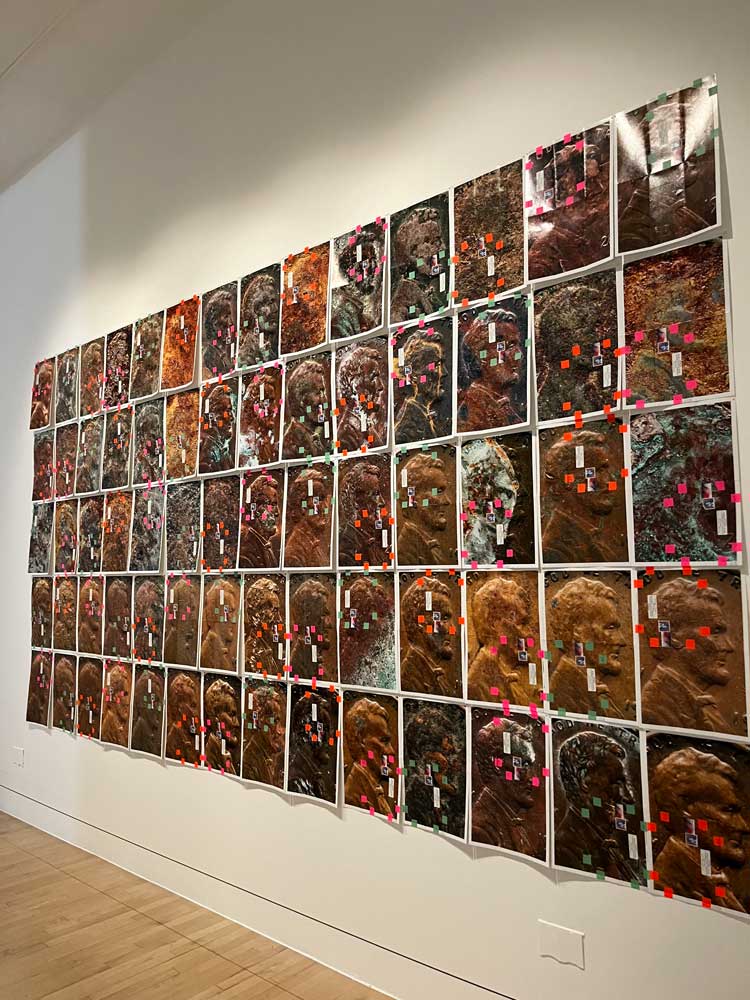
Moyra Davey. Copperheads No. 401-407, Janis J. Portikus, 1990-2017. Installation view, Talbot Rice Gallery, 2023. Photo: Veronica Simpson.
The coins’ journeys are further articulated through the creases in these photos, where Davey has folded them to post them to galleries around the world, and then marked them with a red sticker to represent each exhibition, adding another expression of value to them.
All that we have seen so far relies on the viewer to do the work, to look closely enough, to make the connections, whereas a film upstairs by Marwa Arsanios (b1978, Washington DC), gives us a precious 35 minutes in which to sit back and watch a story of land ownership, land use and alternatives, unfold.
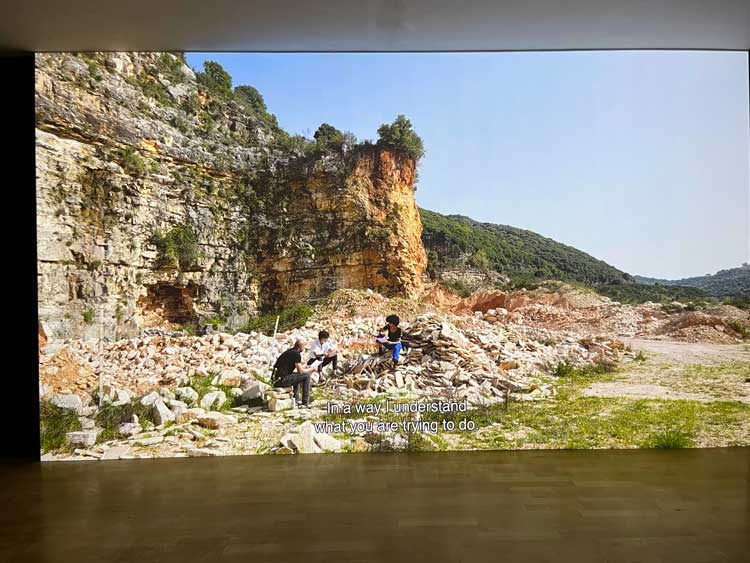
Marwa Arsanios. Who Is Afraid of Ideology? Part 4: Reverse Shot, 2022. Installation view, Talbot Rice Gallery, 2023. Photo: Veronica Simpson.
Part 4: Reverse Shot (2022) was first screened at Documenta 2022. In it, Arsanios, who divides her time between Berlin and Beirut, explores an attempt to turn a piece of Beirut land into a common, exploring ancient laws and philosophies that could justify the move and then looks at what the implications and responsibilities are regarding land that no one owns.
We flow from ancient practices to futuristic in the next work, by terra0, a Berlin-based collective, founded in 2016 by Paul Killing, Paul Seidler and Max Hampshire, while still at university, combining activist issues with digital technology. The work shown here evolved from a project the group developed while they were still studying. It imagines the possibilities of an autonomous, sentient forest that, through smart technology, could manage its own financial and legal affairs, issuing sustainable logging rights and ultimately owning the land on which it stands.
-2018-Pic-V-Simpson.jpg)
Goldin+Senneby. The Plot (Utopia Bloemen), 2018. Installation view, Talbot Rice Gallery, 2023. Photo: Veronica Simpson.
In the delightful Round Room, a few yards away, soft daylight pours down from a Georgian circular rooflight caressing mysterious patterns stencilled on to its walls, thanks to Goldin+Senneby’s The Plot (Utopia Bloemen) (2018). This duo, founded in 2004 in Stockholm, where it is still based, has created a series of Plots, exploring the double meaning of the word as narrative device and a piece of land. This one was made in response to their acquisition of an area of wasteland at a former coalmine in Belgium. Finding fossils there from a 350m-year-old carboniferous forest, they responded by incorporating patterns from the fossils into the stencils we see here, which are laboriously reproduced (by gallery staff) with coal from the plot and Vaseline (a petroleum product). It gives the room a subtle scent and enriches its tactile quality. An artist’s plein-air painting structure is placed at the work’s centre, containing in its drawers the deeds to the plot, a replica of a stencil, and a poem by Belgium’s poet laureate, Mustafa Kör, about the horrors of deep mining work, inspired by his father who was a miner there. Clegg says: “This poem is called Utopian Flowers and speaks of the mortal hunger of workers entering the underbelly of various countries. As they dig through ancient matter, the poem alludes to a transcendental encounter with the longer ancestral histories of the Earth.”
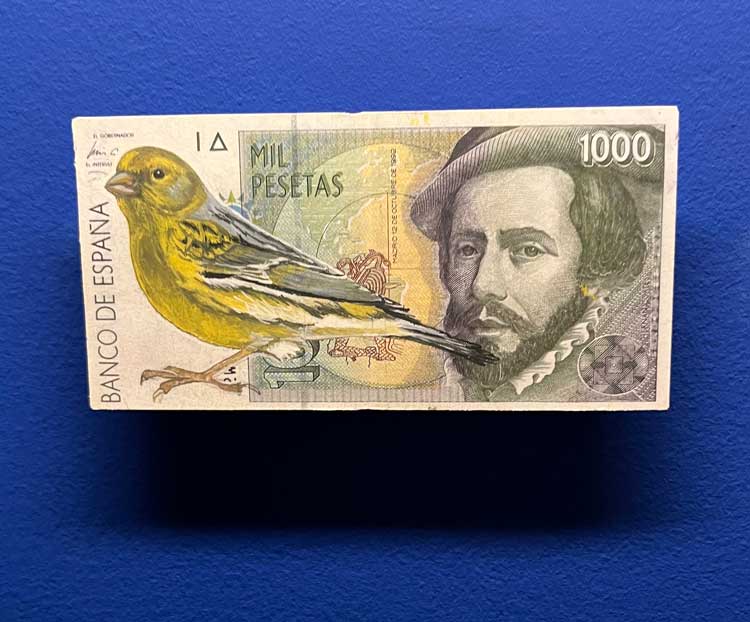
Hanna von Goeler. Atlantic Canary on defunct Spanish pesetas, from Migration series, 2016-2023. Photo: Veronica Simpson.
From the bowels of the Earth to the heavens we proceed, thanks to Hanna von Goeler’s birds, arranged against a background of lapis lazuli blue along the upper walls of the Georgian Gallery. Von Goeler’s Migration series of exquisitely captured watercolours of birds painted on to defunct banknotes has surely never had a more resonant context. The placement of bird and currency is intentional and strategic – such as a Syrian bird being painted on to Greek currency to signify the refugee crisis. The Talbot Rice Gallery commissioned one of the works shown – it is framed, at the gallery’s far end. On a defunct Scottish banknote, she has painted a grey wagtail – a bird that, during the Highland Clearances, was widely believed to signify you were next, if it landed between you and your front door.
Clegg says: “We spent a lot of time picking the background colour. I wanted to reference art history, but then there was a period when this lapis lazuli became more precious than gold. But, also, it’s the blue of the sky and limitless horizons.”
We arrive here after we have (hopefully) done the hard work of joining the dots about the systems and seductions of a world of debt in which we are all enmeshed. It may be hard work, at times, to find all the rich threads that inform and connect these works, but you will be intellectually richer for the effort.